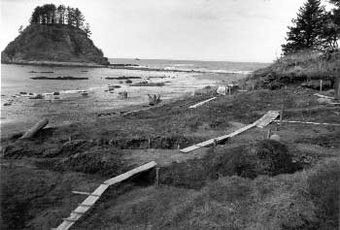Ozette Indian Village Archeological Site facts for kids
Quick facts for kids |
|
|
Ozette Native American Village Archaeological Site
|
|
 |
|
| Lua error in Module:Location_map at line 420: attempt to index field 'wikibase' (a nil value). | |
| Location | Address restricted |
|---|---|
| Nearest city | Neah Bay, Washington |
| NRHP reference No. | 74000916 |
| Added to NRHP | January 11, 1974 |
The Ozette Native American Village Archaeological Site is a special place on the Olympic Peninsula in Washington, USA. It's where archaeologists found an ancient village of the Makah people. This village was suddenly covered by a huge mudslide around the year 1750. The mudslide actually helped preserve the village and its treasures for hundreds of years!
Today, the site is within the Ozette Indian Reservation, which is not populated. You can reach the area by taking the Hoko-Ozette Road, which connects to Washington State Route 112. This road leads to the NPS Lake Ozette Ranger Station, located inside Olympic National Park. The Ranger Station is about 3 miles from the old village site.
Long ago, in the late 1800s, some of the first European settlers in this far western part of the Olympic Peninsula were Scandinavian immigrants. They built a small community between the Pacific Ocean coast and the Ozette River.
This beautiful area is now popular with people who love to hike. Many enjoy the 9.5-mile Ozette Loop trail. It starts and ends at the Lake Ozette Ranger Station and takes you to scenic spots like Sand Point and Cape Alava.
In 1997, people from Mihama, Japan, visited Ozette. They came to remember three Japanese sailors whose ship crashed nearby in 1834. The Makah people helped these sailors before they traveled to Fort Vancouver.
Contents
Discovering the Ancient Ozette Village
Around the year 1560, a massive mudslide buried part of a Makah village. This happened along the coast of what is now Washington, near Lake Ozette. This natural disaster actually saved the village from decay.
Archaeologists first explored the Ozette site in 1966 and 1967. But it wasn't until February 1970 that the real secret was revealed. A big storm caused ocean tides to wash away some mud. This exposed hundreds of amazing wooden artifacts that were incredibly well-preserved!
A Village Frozen in Time
Soon after this discovery, the big excavation began. For 11 years, university students worked alongside the Makah people. They used special pressurized water to gently remove mud from six buried long houses. It was like carefully uncovering a time capsule!
The mudslide had kept these houses and their contents safe in a collapsed state. When archaeologists and Makah people from Washington State University finally uncovered them in the 1970s, they found an incredible amount of history.
Uncovering Makah Life
Over 55,000 artifacts were found during the excavation. These items show how the Makah people lived for about 2,000 years. They tell stories of their daily activities, like hunting whales and seals, and fishing for salmon and halibut. There were also toys, games, and hunting tools like bows and arrows.
What's truly amazing is that about 30,000 of these artifacts were made of wood. Wood usually rots away quickly, but the mudslide protected these items perfectly.
Tools and Treasures
Among the discoveries were hundreds of knives. Their blades were made from different materials. Some were from mussel shells, others from sharpened beaver teeth. There were even iron blades, which might have come from Asian ships that wrecked nearby. The Makah people's oral history, passed down through generations, also speaks of a "great slide" that covered part of Ozette long ago.
The Makah Museum Today
The Makah Museum opened in 1979. It proudly displays many of these ancient treasures. You can see replicas of traditional cedar long houses. There are also canoes used for whaling, fishing, and sealing.
The Ozette village existed long before many Europeans visited the area. This means it was thriving before new diseases, brought by Europeans, caused many people to become sick. Because the mudslide buried the village so quickly, Ozette offers a rare look at what a society was like before it was changed by outside influences or before its treasures were lost.

